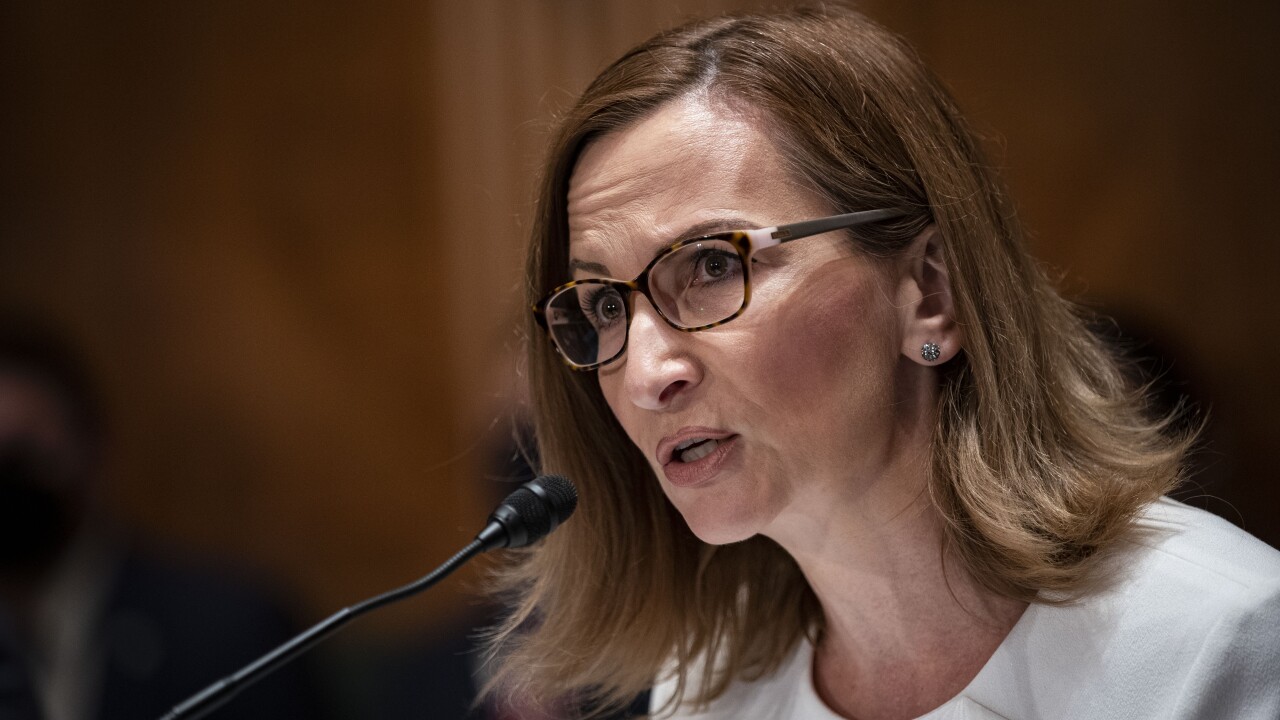WASHINGTON — In its final rule
Perhaps most notably, the OCC's final plan waters down proposed number-based measurements of CRA activity that community groups had blasted, returning some discretion to examiners to judge a bank's overall compliance.
Whether the agency has won over any detractors is yet to be seen. Some groups appeared to dislike the rule as much as before. Still, the result of a multiyear reform process led by Comptroller of the Currency Joseph Otting is a somewhat narrower reform framework that made several accommodations to critics.
“The final rule is the culmination of a multiyear process and reflects more than a decade of dialogue about how to make the CRA work better,” Otting said in an op-ed published Wednesday in American Banker, one day after news broke of his plan to
After the OCC

Ultimately, the CRA reforms unveiled Wednesday only apply to OCC-supervised banks, and the majority of those can opt out under a provision to ease the compliance burden of small banks.
But OCC officials stressed that the agency strived to listen to public concerns about the CRA reform effort in writing the final rule.
“The thing that has impressed me most in my seven or eight weeks at the OCC, watching the final stages of CRA unfold, is how seriously the OCC took the comments that were submitted from multiple different stakeholders in this process,” said OCC Chief Operating Officer Brian Brooks, who many see as a likely acting comptroller after Otting departs. “I think what you'll see when you take time to digest the final rule is, it is significantly different in important ways from what the proposed rule was.”
Here are some key takeaways from the final rule and reaction to it.
Concession on performance standards
Many in the banking industry and among community reinvestment advocates had questioned the proposal's use of prescriptive, quantitative thresholds for evaluating CRA performance, which was based in part on the dollar value of CRA projects.
Critics worried that quantitative measures would put too much weight on large-dollar CRA work, like mortgages, and disincentivize banks from focusing on smaller, more targeted lending.
But the final rule features a major concession. Rather than using fixed percentages suggested in the proposal for certain exam scores — 6% for a “satisfactory” score and 11% for “outstanding” — the final rule concedes that the national bank regulator lacked the data to support those figures.
Instead of prescribing CRA performance thresholds, the OCC will ask banks to submit their CRA data to determine appropriate thresholds.
“The final rule defers setting thresholds for grading banks’ CRA performance until the OCC can assess this improved data,” Otting said in a statement.
On the whole, the changes to the rule try to preserve a focus on qualitative judgments about a bank's CRA activity, rather than just focusing on quantitative measures.
Higher asset thresholds, longer transition period
In addition to applying only to nationally chartered banks and federal thrifts, the final rule also raises the asset threshold for OCC-regulated institutions — from $500 million to $2.5 billion — that can choose to keep the current CRA regime instead of the new one.
In another change based on public comments on the proposal, the rule will also reintroduce a distinction for intermediate-sized banks that face a simpler CRA compliance burden than the largest institutions. The small bank threshold will be raised from $500 million to $600 million, and the intermediate threshold will be capped at $2.5 billion.
According to OCC staff, banks with assets of more than $2.5 billion represent a “significant majority” of the nation’s CRA lending. The OCC has said in the past that its examiners oversee roughly 70% of the country’s CRA lending dollars.
While the new framework is set to initially go into effect in October of this year, banks will not need to contend with the new examination standards for at least two years, and many of the most significant changes — such as new data collection requirements — will not go into effect until January 2024.
OCC's approach on assessment areas largely unchanged from proposal
The core of the OCC’s proposed overhaul of how CRA assessment areas are determined largely stayed the same in the final rule. If more than 50% of a bank’s deposits come from outside of its physical assessment areas, “the bank must delineate separate, non-overlapping ‘deposit-based’ assessment areas,” the final rule says.
In such cases, any geographic area where a bank has a concentration of more than 5% of its deposits would become a new assessment area.
The OCC’s final rule will also give banks more credit for maintaining branches and ATMs in low- to moderate-income areas when it comes to a bank’s branch distribution score.
“Branches continue to play a large and important role in meeting certain communities’ needs and serving certain populations,” the final rule says, adding that the measure “retains the branch distribution component of the CRA evaluation measure and enhances the amount of credit that a bank may receive for branches in LMI census tracts and other identified areas of need.”
It will be tougher for banks to earn CRA credit through financing sports stadiums
The final rule also expands upon the initial proposal’s “illustrative list” of activities most commonly approved for CRA credit by examiners. While the original list stretched 15 pages, the new list has grown to 22 pages.
The agency added activities, including several that revolve around community development lending, investment and services. "This expansion recognized that there are additional activities that meet the credit needs of these populations and areas that are consistent with the statutory purpose of the CRA but that do not currently qualify for CRA credit," the final rule said.
The OCC also clarified the criteria for athletic stadium financing to receive CRA credit, addressing criticism from community groups that including stadiums on the list rewards banks for high-value projects that do not have a clear public benefit.
The new illustrative list says that in order for a bank to receive credit for a sports stadium investment, it should be done through a “qualified opportunity fund” as long as the facility is ”owned and operated for community benefit by a local nonprofit in an opportunity zone that is also an LMI census tract.”
Industry groups commended the OCC's effort, but reaction to the plan is still mixed
Early reactions to the 372-page final rule signal that the fight over the future of the CRA is far from over.
“This is an awkward, disjointed and rushed move by a single agency that couldn’t get agreement from the two other agencies that regulate banks within the same administration,” said Jesse Van Tol, CEO of the National Community Reinvestment Coalition. “The OCC should have been able to agree and work with the other two agencies that oversee enforcement of the same law. It couldn’t. It failed. That’s an administrative fiasco.”
Even the OCC admitted in the text of the final rule that the majority of public feedback it received was not supportive of the proposed framework. "Although commenters disagreed with the approach outlined in the proposal, the agency ultimately agreed with the minority of commenters who expressed support for the proposed framework," the final rule says.
Reaction to the final rule on CRA followed a similar rhythm as the initial proposal. While banks were generally supportive of the OCC’s effort to modernize the 1977 law, some key reservations linger.
The Consumer Bankers Association said in a press release that “the OCC and Comptroller Otting should be commended for attempting to bring an analog regulation into a digital world.”
“The end result lays out a more transparent and objective process for measuring banks’ continued service to their communities,” the CBA said.
But the American Bankers Association emphasized that bankers remain leery of the final rule’s data and recordkeeping requirements, which some estimate will cost the industry billions of dollars in compliance costs in the coming years.
“We remain concerned about key provisions of the final rule including the substance and complexity of the performance measurement benchmarks, which will present significant data collection challenges for banks,” Rob Nichols, the group's president and CEO, said in a statement.
The Independent Community Bankers of America echoed that, writing in a statement that "community banks remain concerned that the new regulatory framework is too complex and would impose new and excessive data-collection costs that could inhibit their ability to serve local communities."
Bankers are also concerned about regulatory arbitrage as the OCC sets out on its own — a fear only magnified by the FDIC’s choice to opt out of the final rule amid the pandemic.
“As the only banking trade association that represents banks of all sizes and charters, we have also advocated for clear and consistent rules for all banks. The fact that only one of the three federal banking regulators overseeing CRA has adopted this final rule means it does not meet that goal,” Nichols said.
Community groups, while acknowledging some of the concessions made by the OCC, remain staunchly opposed to the rule.
“Although some changes have been made to the final rule, much of the final rule retains the problematic original proposal,” the California Reinvestment Coalition said in a press release. “The hastiness of the process calls into question whether the public comments were fully considered, as is required by the laws governing the rulemaking process.”





